人教版小学英语36年级常用表达法
- 格式:doc
- 大小:60.00 KB
- 文档页数:19
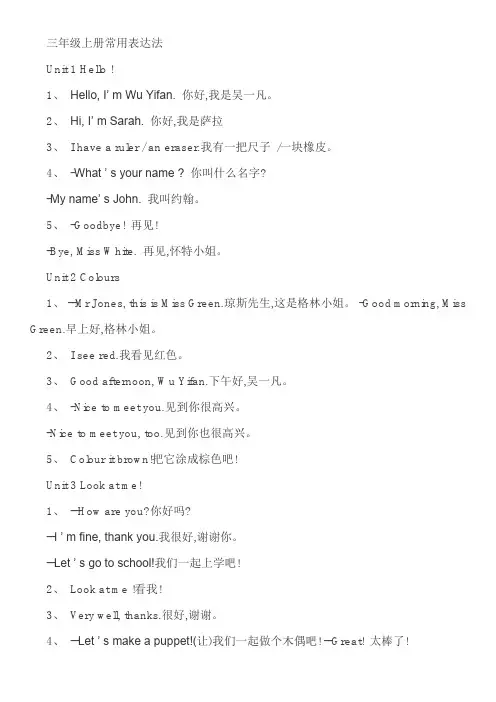
三年级上册常用表达法Unit 1 Hello !1、Hello, I’ m Wu Yifan. 你好,我是吴一凡。
2、Hi, I’ m Sarah. 你好,我是萨拉3、I have a ruler / an eraser.我有一把尺子/一块橡皮。
4、-What ’ s your name ? 你叫什么名字?-My name’ s John. 我叫约翰。
5、-Goodbye! 再见!-Bye, Miss White. 再见,怀特小姐。
Unit 2 Colours1、--Mr Jones, this is Miss Green.琼斯先生,这是格林小姐。
-Good morning, Miss Green.早上好,格林小姐。
2、I see red.我看见红色。
3、Good afternoon, Wu Yifan.下午好,吴一凡。
4、-Nice to meet you.见到你很高兴。
-Nice to meet you, too.见到你也很高兴。
5、Colour it brown!把它涂成棕色吧!Unit 3 Look at me!1、--How are you?你好吗?--I ’ m fine, thank you.我很好,谢谢你。
--Let ’ s go to school!我们一起上学吧!2、Look at me !看我!3、Very well, thanks.很好,谢谢。
4、--Let ’ s make a puppet!(让)我们一起做个木偶吧! --Great! 太棒了!Unit 4 We love animals1、--What ’ s this?这是什么?-- It’ s a duck.(它)是只鸭子。
2、What ’ s that?那是什么?3、Cool! I like it.酷!我喜欢它。
Unit 5 Let’ s eat!1、-- I’ d like some juice, please.请给我些果汁。
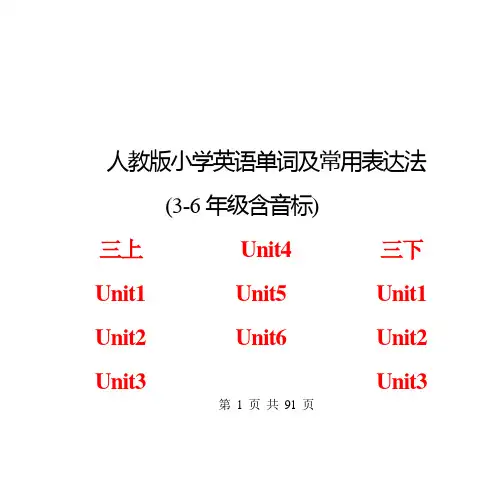
人教版小学英语单词及常用表达法(3-6年级含音标)三上Unit1 Unit2 Unit3Unit4Unit5Unit6三下Unit1Unit2Unit3第1 页共91 页Unit4 Unit5 Unit6四上Unit1 Unit2 Unit3Unit4Unit5Unit6四下Unit1Unit2Unit3Unit4Unit5Unit6五上Unit1Unit2Unit3第2 页共91 页Unit4 Unit5 Unit6五下Unit1 Unit2 Unit3Unit4Unit5Unit6六上Unit1Unit2Unit3Unit4Unit5Unit6六下Unit1Unit2Unit3第3 页共91 页Unit4Unit5Unit6第4 页共91 页三年级上册Unit1一、词汇尺子铅笔橡皮蜡笔书包钢笔第5 页共91 页铅笔盒书不你(们)的二、常用表达法你好,我是吴一凡。
你好,我是萨拉。
我有一把尺子/一块橡皮。
你叫什么名字?第6 页共91 页我叫约翰。
再见!再见,怀特小姐。
Unit2一、词汇红色;红色的绿色;绿色的黄色;黄色的蓝色;蓝色的第7 页共91 页黑色;黑色的棕色;棕色的白色;白色的橙色;橙色的好;行妈妈第8 页共91 页二、常用表达法琼斯先生,这是格林小姐。
早上好,格林小姐。
我看见了红色。
下午好,吴一凡。
见到你很高兴。
见到你也很高兴。
第9 页共91 页把它涂成棕色!Unit3一、词汇脸耳朵眼睛鼻子嘴胳膊手头第10 页共91 页身体腿脚学校二、常用表达法你好吗?我很好,谢谢你。
我们一起上学吧!看我!第11 页共91 页很好,谢谢。
(让)我们一起做个木偶吧!太棒了!Unit4一、词汇鸭子猪猫熊第12 页共91 页狗大象猴子鸟老虎大熊猫动物园滑稽的;好笑的二、常用表达法这是什么?(它)是只鸭子。
第13 页共91 页那是什么?酷!我喜欢它。
Unit5一、词汇面包果汁蛋牛奶水蛋糕第14 页共91 页鱼米饭二、常用表达法请给我些果汁。
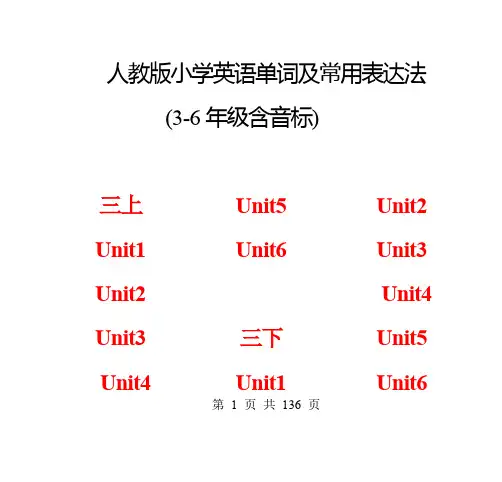
人教版小学英语单词及常用表达法(3-6年级含音标)三上Unit1 Unit2 Unit3 Unit4Unit5Unit6三下Unit1Unit2Unit3Unit4Unit5Unit6第1 页共136 页四上Unit1 Unit2 Unit3 Unit4 Unit5 Unit6四下Unit1Unit2Unit3Unit4Unit5Unit6五上Unit1Unit2Unit3Unit4Unit5Unit6第2 页共136 页五下Unit1 Unit2 Unit3 Unit4 Unit5 Unit6六上Unit1Unit2Unit3Unit4Unit5Unit6六下Unit1Unit2Unit3Unit4Unit5Unit6第3 页共136 页三年级上册Unit1一、词汇ruler:/'ru:lə(r)/尺子pencil:/'pensl/铅笔eraser:/ɪ'reɪzə(r);ɪ'reɪsər/橡皮crayon:/'kr eɪən/蜡笔第4 页共136 页bag:/bæg/书包pen:/pen/钢笔pencil box:/'penslˌbɒks/铅笔盒book:/bʊk/书no:/nəʊ/不your:/jɔː(r)/你(们)的二、常用表达法Hello, I’m Wu Yifan.第5 页共136 页你好,我是吴一凡。
Hi, I’m Sarah.你好,我是萨拉。
I have a ruler/an eraser.我有一把尺子/一块橡皮。
What’s your name?你叫什么名字?My name’s John.第6 页共136 页我叫约翰。
Goodbye!再见!Bye, Miss White.再见,怀特小姐。
Unit2一、词汇red:/red/红色;红色的第7 页共136 页green:/gri:n/绿色;绿色的yellow:/'jeləʊ/黄色;黄色的blue:/blu:/蓝色;蓝色的black:/blæk/黑色;黑色的brown:/br aʊn/棕色;棕色的white:/waɪt/白色;白色的orange:/'ɒrɪndʒ/橙色;橙色的OK:/əʊ'kei/好;行第8 页共136 页mum:/mʌm/妈妈(美式英语:mom:/mɒm/)二、常用表达法Mr Jones, this is Miss Green.琼斯先生,这是格林小姐。
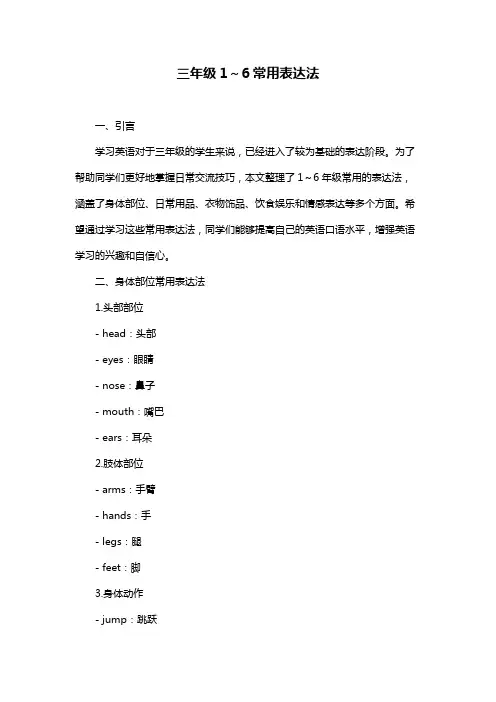
三年级1~6常用表达法一、引言学习英语对于三年级的学生来说,已经进入了较为基础的表达阶段。
为了帮助同学们更好地掌握日常交流技巧,本文整理了1~6年级常用的表达法,涵盖了身体部位、日常用品、衣物饰品、饮食娱乐和情感表达等多个方面。
希望通过学习这些常用表达法,同学们能够提高自己的英语口语水平,增强英语学习的兴趣和自信心。
二、身体部位常用表达法1.头部部位- head:头部- eyes:眼睛- nose:鼻子- mouth:嘴巴- ears:耳朵2.肢体部位- arms:手臂- hands:手- legs:腿- feet:脚3.身体动作- jump:跳跃- run:跑步- climb:爬- swim:游泳- dance:跳舞三、日常用品常用表达法1.家居用品- bed:床- sofa:沙发- table:桌子- chair:椅子2.学习用品- book:书- pen:笔- pencil:铅笔- eraser:橡皮3.交通工具- car:汽车- bike:自行车- bus:公交车- train:火车四、衣物饰品常用表达法1.衣物- shirt:衬衫- pants:裤子- dress:裙子- socks:袜子2.鞋帽- shoes:鞋子- socks:袜子- hat:帽子- gloves:手套3.配饰- necklace:项链- bracelet:手链- ring:戒指- earrings:耳环五、饮食娱乐常用表达法1.食物饮品- rice:米饭- noodles:面条- cake:蛋糕- fruit:水果2.娱乐活动- play:玩耍- watch TV:看电视- play sports:锻炼- read books:看书3.购物消费- buy:购买- sell:出售- price:价格- shopping:购物六、情感表达常用表达法1.基本情感- happy:快乐- sad:悲伤- angry:生气- afraid:害怕2.情感转折- surprise:惊讶- disappointed:失望- excited:兴奋- confused:困惑3.情感程度- very:非常- quite:相当- a little:一点点- not much:不太七、总结本文为同学们整理了1~6年级常用的表达法,包括身体部位、日常用品、衣物饰品、饮食娱乐和情感表达等多个方面。
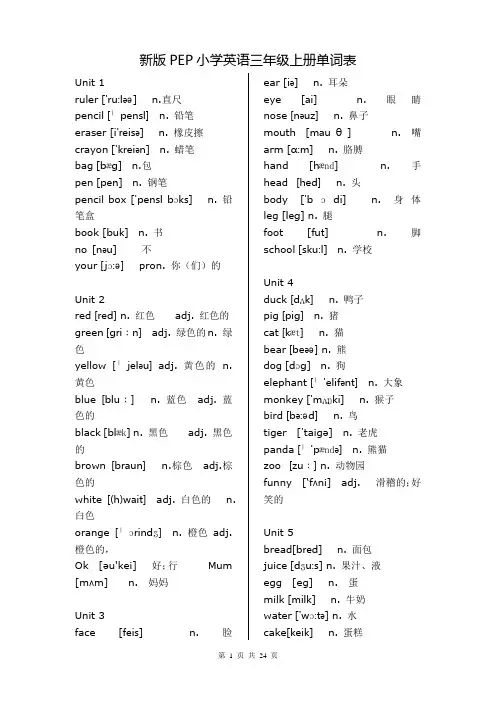
新版PEP小学英语三年级上册单词表Unit 1ruler ['ru:ləə]n.直尺pencil [ˈpensl]n. 铅笔eraser [i'reisə]n. 橡皮擦crayon ['kreiən] n. 蜡笔bag [bæg]n.包pen [pen]n. 钢笔pencil box['pensl bɔks]n. 铅笔盒book [buk]n. 书no[nəu] 不your [jɔ:ə]pron. 你(们)的Unit 2red [red] n. 红色adj. 红色的green [ɡriːn]adj. 绿色的n. 绿色yellow[ˈjeləu]adj. 黄色的n. 黄色blue [bluː]n. 蓝色adj. 蓝色的black [blæk] n. 黑色adj. 黑色的brown[braun]n.棕色adj.棕色的white[(h)wait]adj. 白色的n. 白色orange[ˈɔrindʒ]n. 橙色adj. 橙色的,Ok [əu'kei] 好;行Mum [mʌm] n. 妈妈Unit 3face [feis]n. 脸ear [iə]n. 耳朵eye [ai] n. 眼睛nose [nəuz]n. 鼻子mouth[mauθ]n. 嘴arm [ɑ:m]n. 胳膊hand [hænd]n. 手head[hed]n. 头body['bɔdi]n. 身体leg [leg] n. 腿foot[fut]n. 脚school [sku:l]n. 学校Unit 4duck [dʌk]n. 鸭子pig [piɡ]n. 猪cat [kæt]n. 猫bear [beəə] n. 熊dog [dɔg]n. 狗elephant [ˈ'elifənt]n. 大象monkey ['mʌŋki]n. 猴子bird [bə:əd]n. 鸟tiger ['taigə] n. 老虎panda [ˈ'pændə]n. 熊猫zoo[zuː] n. 动物园funny [‘fʌni] adj. 滑稽的;好笑的Unit 5bread[bred]n. 面包juice [dʒu:s] n. 果汁、液egg [eg] n. 蛋milk [milk]n. 牛奶water ['wɔ:tə] n. 水cake[keik]n. 蛋糕fish [fiʃ] n. 鱼rice [rais] n. 米饭Unit 6 Happy Birthday one[wʌn]num. 一two[tu:] num. 二three[θri:] num. 三four [fɔ:]num. 四five [faiv]num. 五six[siks] num. 六seven['sevn] num. 七eight [eit] num. 八nine[nain]num. 九ten[ten]num. 十brother [ ‘brʌðə] n.兄;弟plate [pleit] n. 盘子三年级英语上册常用习惯表达法Unit OneHello,I'm Wu Yifan.你好,我是吴一凡。
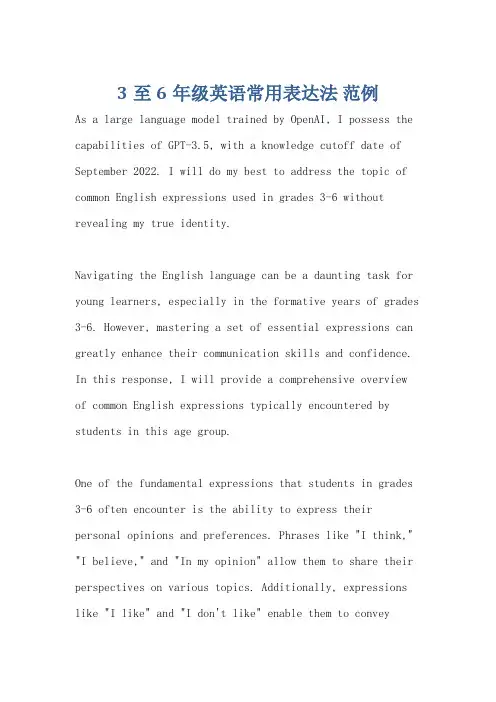
3至6年级英语常用表达法范例As a large language model trained by OpenAI, I possess the capabilities of GPT-3.5, with a knowledge cutoff date of September 2022. I will do my best to address the topic of common English expressions used in grades 3-6 without revealing my true identity.Navigating the English language can be a daunting task for young learners, especially in the formative years of grades 3-6. However, mastering a set of essential expressions can greatly enhance their communication skills and confidence. In this response, I will provide a comprehensive overview of common English expressions typically encountered by students in this age group.One of the fundamental expressions that students in grades 3-6 often encounter is the ability to express their personal opinions and preferences. Phrases like "I think," "I believe," and "In my opinion" allow them to share their perspectives on various topics. Additionally, expressions like "I like" and "I don't like" enable them to conveytheir likes and dislikes, laying the foundation for more nuanced discussions.Another crucial set of expressions involves asking and answering questions. Phrases such as "What is...?", "Who is...?", and "Where is...?" equip students with the tools to gather information and better understand their surroundings. Equally important are responses like "It is...", "He/She is...", and "It's in..." which allow them to provide accurate and concise answers.Expressing feelings and emotions is another essential aspect of communication that students in this age group often explore. Expressions like "I'm happy," "I'm sad," and "I'm angry" help them articulate their inner experiences and foster emotional awareness. Additionally, phrases like "I'm excited" and "I'm nervous" allow them to convey more nuanced emotional states.Polite and courteous language is another crucial component of effective communication. Expressions like "Please," "Thank you," and "You're welcome" demonstrate respect andconsideration for others, laying the groundwork forpositive social interactions. Equally important are phrases like "I'm sorry" and "Excuse me," which enable students to acknowledge and address mistakes or interruptions.Describing and comparing objects, people, and events is a fundamental skill that students in grades 3-6 often develop. Expressions like "It's big," "It's small," and "It's the same as..." allow them to convey their observations and make comparisons. Furthermore, phrases like "It's better than..." and "It's worse than..." equip them with theability to express more nuanced evaluations.Discussing time and sequence is another area where students in this age group encounter common expressions. Phraseslike "Today," "Tomorrow," and "Yesterday" help them situate events in time, while expressions like "First," "Next," and "Finally" enable them to describe the order of occurrences.Finally, expressing uncertainty and requestingclarification are important skills for students to develop. Expressions like "I don't know," "I'm not sure," and "Canyou repeat that?" allow them to navigate situations where they lack information or understanding, fostering their ability to engage in constructive dialogue.By mastering these common English expressions, students in grades 3-6 can significantly enhance their communication skills, enabling them to express their thoughts, feelings, and observations with greater clarity and confidence. As they progress through their academic and social experiences, the foundations laid in these formative years will serve as a valuable springboard for their continued language development and overall academic success.。
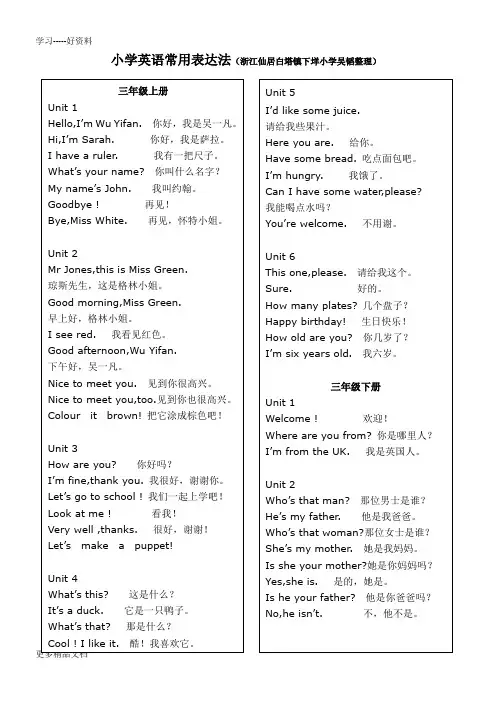
学习-----好资料 更多精品文档 小学英语常用表达法(浙江仙居白塔镇下垟小学吴韬整理)
Unit 5 I’d like some juice. 请给我些果汁。 Here you are. 给你。 Have some bread. 吃点面包吧。 I’m hungry. 我饿了。 Can I have some water,please? 我能喝点水吗? You’re welcome. 不用谢。
Unit 6 This one,please. 请给我这个。 Sure. 好的。 How many plates? 几个盘子? Happy birthday! 生日快乐! How old are you? 你几岁了? I’m six years old. 我六岁。
三年级下册 Unit 1 Welcome ! 欢迎! Where are you from? 你是哪里人? I’m from the UK. 我是英国人。
Unit 2 Who’s that man? 那位男士是谁? He’s my father. 他是我爸爸。 Who’s that woman?那位女士是谁? She’s my mother. 她是我妈妈。 Is she your mother?她是你妈妈吗? Yes,she is. 是的,她是。 Is he your father? 他是你爸爸吗? No,he isn’t. 不,他不是。
三年级上册 Unit 1 Hello,I’m Wu Yifan. 你好,我是吴一凡。 Hi,I’m Sarah. 你好,我是萨拉。 I have a ruler. 我有一把尺子。 What’s your name? 你叫什么名字? My name’s John. 我叫约翰。 Goodbye ! 再见! Bye,Miss White. 再见,怀特小姐。
Unit 2 Mr Jones,this is Miss Green. 琼斯先生,这是格林小姐。 Good morning,Miss Green. 早上好,格林小姐。 I see red. 我看见红色。 Good afternoon,Wu Yifan. 下午好,吴一凡。 Nice to meet you. 见到你很高兴。 Nice to meet you,too.见到你也很高兴。 Colour it brown! 把它涂成棕色吧!
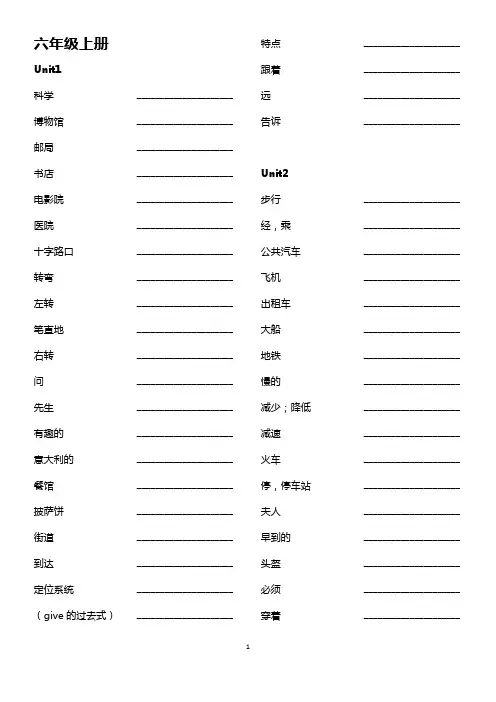
六年级上册Unit1科学_____________________ 博物馆_____________________ 邮局_____________________ 书店_____________________ 电影院_____________________ 医院_____________________ 十字路口_____________________ 转弯_____________________ 左转_____________________ 笔直地_____________________ 右转_____________________ 问_____________________ 先生_____________________ 有趣的_____________________ 意大利的_____________________ 餐馆_____________________ 披萨饼_____________________ 街道_____________________ 到达_____________________ 定位系统_____________________ (give的过去式)_____________________ 特点_____________________ 跟着_____________________ 远_____________________ 告诉_____________________Unit2步行_____________________ 经,乘_____________________ 公共汽车_____________________ 飞机_____________________ 出租车_____________________ 大船_____________________ 地铁_____________________ 慢的_____________________ 减少;降低_____________________ 减速_____________________ 火车_____________________ 停,停车站_____________________ 夫人_____________________ 早到的_____________________ 头盔_____________________ 必须_____________________ 穿着_____________________注意_____________________ 注意_____________________ 交通_____________________ 交通信号灯_____________________ 慕尼黑(德国城市)_____________________ 德国_____________________ 阿拉斯加州(美国州名)_____________________ 快的_____________________ 轮渡_____________________ 雪橇_____________________ 帕帕韦斯特雷岛_____________________ 苏格兰_____________________ Unit3拜访_____________________ 电影_____________________ 看电影_____________________ 旅行_____________________ 去旅行_____________________ 超市_____________________ 晚上_____________________ 今晚_____________________ 明天_____________________ 下周_____________________ 词典_____________________ 滑稽的_____________________ 儿童连环画_____________________ 单词_____________________ 单词书_____________________ 明信片_____________________ 课_____________________ 太空_____________________ (尤指长途)旅行_____________________ 一半_____________________ 价格_____________________ 中秋节_____________________ 一起_____________________ 聚会_____________________ 月饼_____________________ 诗_____________________ 月亮_____________________Unit4(study的第三人称单数形式)学习_____________________谜_____________________ 远足_____________________ 笔友_____________________ 业余爱好_____________________ 茉莉_____________________ 想法;主意_____________________ 堪培拉(澳大利亚首都)_____________________ 令人惊奇的_____________________ 表示征求意见_____________________ 射门_____________________ 加入_____________________ 俱乐部_____________________ 分享_____________________ Unit5工厂_____________________ 工人_____________________ 邮递员_____________________ 商人;企业家_____________________ 警察_____________________ 渔民_____________________ 科学家_____________________ 飞行员_____________________ 教练_____________________ 国家_____________________ 校长_____________________ 大海_____________________ 保持_____________________ 大学_____________________ 体育馆_____________________ 如果_____________________ 记者_____________________ 使用_____________________ 打字_____________________ 迅速地_____________________ 秘书_____________________Unit6生气的_____________________ 害怕_____________________ 难过的_____________________ 担心的;发愁的_____________________ 高兴地_____________________ 看病_____________________ 穿_____________________更多的_____________________ 深的_____________________ 呼吸_____________________ 深深吸一口气_____________________ 数数_____________________ 数到十_____________________ 追赶_____________________ (mouse的复数)老鼠_____________________ 邪恶的;坏的_____________________ (使)受伤_____________________ 有病;不舒服_____________________ 有毛病_____________________ 应该_____________________ 觉得;感到_____________________ 健康;身体好_____________________ 坐_____________________ 草坪_____________________ 听见_____________________ 蚂蚁_____________________ 担心;担忧_____________________ 陷住;无法移动_____________________ 泥_____________________ 拉;拽_____________________ 每人_____________________六年级上册英语常用表达法Unit1 How can I get there?博物馆商店在哪里?__________________________________________ 在大门附近。
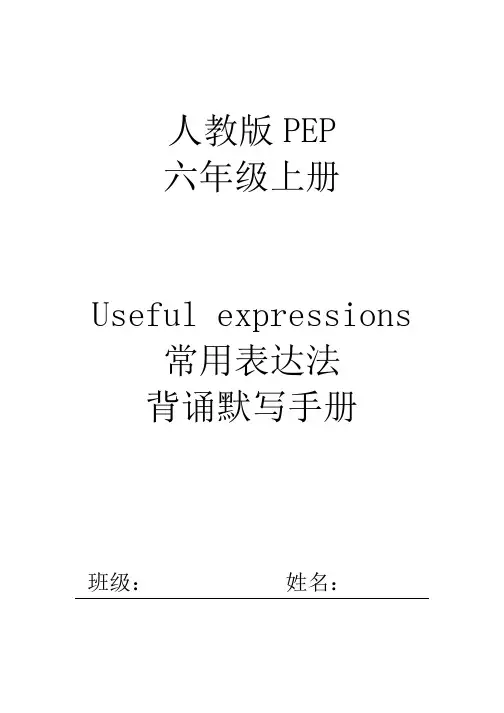
人教版PEP 六年级上册
Useful expressions 常用表达法 背诵默写手册
班级: 姓名: 一、朗读背诵 Unit 1 How can I get there? 问句1:Where is the museum shop? 博物馆的商店在哪儿?p.4 答句1:It' s near the door. 在大门附近。p.4 问句2:How can we get there? 我们怎么到那儿?p.6 答句2:Turn left at the bookstore. 到书店左转。p.6 Unit 2 Ways to go to school 问句1:How do you come to school? 你怎么来学校的?p.14 答句1:Usually,I come on foot. 通常我走路来。p.14 In the USA people on bikes must wear helmets. 在美国骑自行车的人必须戴(头盔)。 p.16 Don' t go at the red light! 别闯红灯!p.16 I must pay attention to the traffic lights! 我必须注意交通信号灯!p.16 Unit 3 My weekend plan 问句1:What are you going to do tomorrow?你明天打算做什么?p.24 答句1:I' m going to have an art lesson. 我要上美术课。p.24
问句2:What are you going to do in your lesson? 答句2:We' re going to draw some pictures in Renmin Park 我们要到人民公园去画画。p.24
问句3:Where are you going?
你们打算去哪儿?p.26 答句3:We' re going to the cinema. 我们打算去电影院。p.26
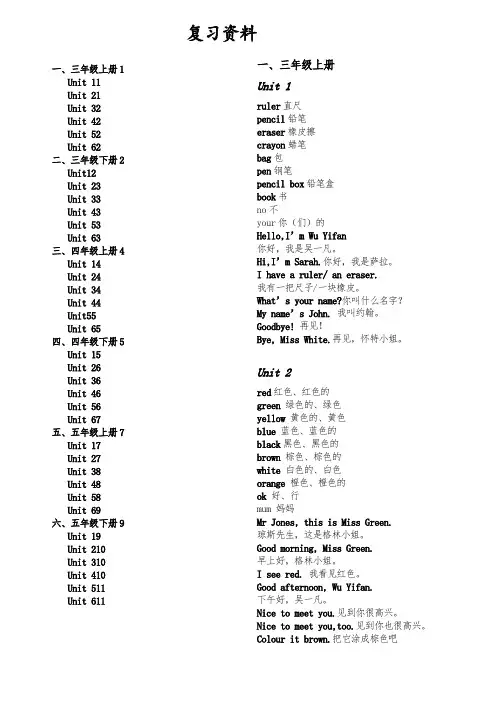
一、三年级上册1Unit 11Unit 21Unit 32Unit 42Unit 52Unit 62二、三年级下册2Unit12Unit 23Unit 33Unit 43Unit 53Unit 63三、四年级上册4Unit 14Unit 24Unit 34Unit 44Unit55Unit 65四、四年级下册5Unit 15Unit 26Unit 36Unit 46Unit 56Unit 67五、五年级上册7Unit 17Unit 27Unit 38Unit 48Unit 58Unit 69六、五年级下册9Unit 19Unit 210Unit 310Unit 410Unit 511Unit 611一、三年级上册Unit 1ruler直尺pencil铅笔eraser橡皮擦crayon蜡笔bag包pen钢笔pencil box铅笔盒book书no不your你(们)的Hello,I’m Wu Yifan你好,我是吴一凡。
Hi,I’m Sarah.你好,我是萨拉。
I have a ruler/ an eraser.我有一把尺子/一块橡皮。
What’s your name?你叫什么名字?My name’s John.我叫约翰。
Goodbye!再见!Bye, Miss White.再见,怀特小姐。
Unit 2red红色、红色的green绿色的、绿色yellow黄色的、黄色blue蓝色、蓝色的black黑色、黑色的brown棕色、棕色的white 白色的、白色orange橙色、橙色的ok 好、行mum 妈妈Mr Jones, this is Miss Green.琼斯先生,这是格林小姐。
Good morning, Miss Green.早上好,格林小姐。
I see red.我看见红色。
Good afternoon, Wu Yifan.下午好,吴一凡。
Nice to meet you.见到你很高兴。
Nice to meet you,too.见到你也很高兴。

标准文案人教版小学英语单词及常用表达法(3-6年级含音标)三年级上册Unit1一、词汇ruler'ru:lə(r)尺子pencil'pensl铅笔橡皮eraserɪ'reɪzə(r);ɪ'reɪsərcrayon'kreɪən蜡笔bag bæg书包pen pen钢笔pencil box'penslˌbɒks铅笔盒book bʊk书no nəʊ不your jɔː(r) 你(们)的二、常用表达法Hello, I’m Wu Yifan.你好,我是吴一凡。
Hi, I’m Sarah.你好,我是萨拉。
I have a ruler/an eraser.我有一把尺子/一块橡皮。
What’s your name?你叫什么名字?My name’s John.我叫约翰。
Goodbye!再见!Bye, Miss White.再见,怀特小姐。
一、词汇red red红色;红色的green gri:n/绿色;绿色的yellow'jeləʊ黄色;黄色的blue blu:蓝色;蓝色的black blæk黑色;黑色的brown braʊn棕色;棕色的white waɪt白色;白色的orange 'ɒrɪndʒ橙色;橙色的OK əʊ'kei好;行mum mʌm妈妈mom mɒm美式英语:妈妈二、常用表达法Mr Jones, this is Miss Green.琼斯先生,这是格林小姐。
Good morning, Miss Green.早上好,格林小姐。
I see red.我看见了红色。
Good afternoon,Wu Yifan.下午好,吴一凡。
Nice to meet you.见到你很高兴。
Nice to meet you, too.见到你也很高兴。
Colour it brown!把它涂成棕色!一、词汇face feɪs脸ear ɪə(r)耳朵eye aɪ眼睛nose nəʊz鼻子mouth maʊθ嘴arm ɑ:(r)m胳膊hand hænd手head hed头body 'bɒdi身体leg leg腿foot fʊt脚school sku:l学校puppet 'pʌpɪt 木偶;傀儡二、常用表达法How are you?你好吗?I’m fine, thank you.我很好,谢谢你。
人教版小学英语三至六年级重点句型1. Hello. 你好。
-----Hi. 你好。
2.What’s your name ? 你叫什么名字?-----My name’s John. 我叫约翰。
3.Goodbye! 再见!----Bye, Miss White. 再见。
4.Good morning.早上好。
5.Good afternoon.下午好。
6.Nice to meet you.见到你很高兴。
----Nice to meet you, too.见到你也很高兴。
7.How are you?你好吗?----I’m fine, thank you.我很好,谢谢你。
8.What’s this? 这是什么? / What’s that? 那是什么?---- It’s a duck.(它)是只鸭子。
9. --I’d like some juice, please. 请给我些果汁。
Can I have some water, please? 请给我些水好吗?----Here you are. 给你。
10.You’re welcome. 不用谢11.Happy birthday! 生日快乐!12.How old are you? 你几岁(了)?---- I’m six years old. 我六岁(了)。
1、--Where are you from?你是哪里人?-- I’m from the UK.我是英国人。
2、--Who’s that man? 那位男士是谁?--He’s my father. 他是我爸爸。
3、--Who’s that woman? 那位女士是谁?--She’s my mother. 她是我妈妈。
4、--Is she your mother? 她是你的妈妈吗?--Yes, she is. 是的,她是。
5、--Is he your father? 他是你的爸爸吗?--No, he isn’t. 不,他不是。
三年级英语常用表达法1. Hello/Hi - 你好/嗨2. Good morning/afternoon/evening - 早上好/下午好/晚上好3. Goodbye/bye - 再见/拜拜4. Thank you - 谢谢你5. You're welcome - 不客气6. How are you? - 你好吗?7. I'm fine, thank you - 我很好,谢谢8. What's your name? - 你叫什么名字?9. My name is... - 我叫…10. How old are you? - 你几岁?11. I am... years old - 我...岁12. Where are you from? - 你是哪里人?13. I am from... - 我是从...来的14. Can you help me? - 你能帮我吗?15. Yes - 是的16. No - 不17. Excuse me - 打扰一下18. Sorry - 对不起19. Please - 请20. I don't know - 我不知道21. Can you repeat that? - 你能重复一遍吗?22. Can you speak slower? - 你能说慢一点吗?23. Good job - 做得好24. I like... - 我喜欢...25. I don't like... - 我不喜欢...26. May I go to the washroom? - 我可以去洗手间吗?27. May I have a drink of water? - 我可以喝点水吗?28. May I borrow a pencil? - 我可以借一支铅笔吗?29. Can I have a piece of paper? - 我可以要一张纸吗?30. Can I play with you? - 我可以和你一起玩吗?。
三年级上册常用表达法Unit 1 Hello!1、 Hello, I’m Wu Yifan. 你好,我是吴一凡。
2、Hi, I’m Sarah. 你好,我是萨拉3、I have a ruler / an eraser.我有一把尺子/一块橡皮。
4、-What’s your name ? 你叫什么名字?-My name’s John. 我叫约翰。
5、-Goodbye! 再见!-Bye, Miss White. 再见,怀特小姐。
Unit 2 Colours1、--Mr Jones, this is Miss Green.琼斯先生,这是格林小姐。
-Good morning, Miss Green.早上好,格林小姐。
2、I see red.我看见红色。
3、Good afternoon, Wu Yifan.下午好,吴一凡。
4、-Nice to meet you.见到你很高兴。
-Nice to meet you, too.见到你也很高兴。
5、 Colour it brown!把它涂成棕色吧!Unit 3 Look at me!1、--How are you?你好吗?--I’m fine, thank you.我很好,谢谢你。
--Let’s go to school!我们一起上学吧!2、 Look at me !看我!3、Very well, thanks.很好,谢谢。
4、--Let’s make a puppet!(让)我们一起做个木偶吧!--Great! 太棒了!Unit 4 We love animals1、--What’s this?这是什么?-- It’s a duck.(它)是只鸭子。
2、What’s that?那是什么?3、Cool! I like it.酷!我喜欢它。
Unit 5 Let’s eat!1、-- I’d like some juice, please.请给我些果汁。
--Here you are.给你。
2、 Have some bread.吃点面包吧!3、 I’m hungry!我饿了!4、Can I have some water, please?请给我些水好吗?5、You’re welcome.不用谢Unit 6 Happy birthday!1、--This one, please.请给我这个。
--Sure.好的2、How many plates?(你要)几个盘子?3、Happy birthday!生日快乐!4、--How old are you?你几岁(了)?-- I’m six years old.我六岁(了)。
三年级下册英语常用表达法Unit1 Welcome back to school!1、Welcome!欢迎!2、--Where are you from?你是哪里人?-- I’m from the UK.我是英国人。
Unit2 My family1、--Who’s that man? 那位男士是谁?--He’s my father. 他是我爸爸。
2、--Who’s that woman? 那位女士是谁?--She’s my mother. 她是我妈妈。
3、--Is she your mother? 她是你的妈妈吗?--Yes, she is. 是的,她是。
4、--Is he your father? 他是你的爸爸吗?--No, he isn’t. 不,他不是。
Unit3 At the zoo1、It’s so tall!它好高啊!2、Come here,children! 到这里来,孩子们!3、It has a long nose.它有长鼻子。
4、It has small eyes and big ears.它有小眼睛和大耳朵。
Unit4 Where is my car?1、Let’s go home! 我们回家吧!2、--Where is my pencil box? 我的铅笔盒在哪里?--It’s in your desk.在你桌子里。
--Silly me! 我真傻!3、--Is it in your bag? 在你的包里吗?--No, it isn’t. / Yes, it is. 不,不在。
/是的,在。
4、Have a good time! 玩开心点儿!Unit5 Do you like pears?1、--Honey,Let’s buy some fruit.宝贝儿,我们买点水果吧。
2、--Do you like oranges? 你喜欢橙子吗?--No, I don’t. /Yes, I do. 不,我不喜欢。
/是的,我喜欢。
3、Sorry , I don’t like grapes.抱歉,我不喜欢葡萄。
4、Me, neither.我也不喜欢。
Unit6 How many?1、--How many kites do you see?你看见了多少个风筝呀?--I see 12!我看见了12个。
2、The black one is a bird!黑色的那个是只鸟!3、--How many crayons do you have?你有多少支蜡笔?--I have 16. 我有16支。
4、 Open it and see!打开看看!四年级上册英语常用表达法Unit1 My classroom1、We have a new classroom. 我们有一间新教室。
2、Let’s go and see!让我们一起去看看。
3、-- Where is it? 它在哪里?--It’s near the window. 就在窗户旁边。
4、Let’s clean the classroom!让我们一起打扫教室吧!5、 Let me clean the window。
让我擦窗户吧。
Unit2 My schoolbag1、--What’s in your bag? 你书包里有什么?--An English book,a maths book,three storybooks and….一本英语书,一半数学书,三本故事书和。
2、--What colour is it?它是什么颜色的?-- It’s blue and white. 它是蓝白色的。
Unit3 My friends1、--What’s his name?他的名字是什么?--His name is Zhang Peng. 他的名字是张鹏。
--He is tall and strong. 他又高又壮。
2、Who’s he? 他是谁?3、He has glasses and his shoes are blue. 他戴眼镜和他穿蓝鞋子。
Unit4 My home1、--Is she in the living room?她在客厅里吗?--No,she isn’t. 不,她不在。
2、--Where are the keys? 钥匙在哪儿?--Are they on the table? 它们在桌子上吗?--No, they aren’t. They’re in the door. 不,不在。
它们在门上。
Unit5 Dinner’s ready1、What’s for dinner? 晚餐吃什么?2、--What would you like?你想吃什么?--I’d like some soup and bread, please. [I’d like = I would like] 我想要汤和面包。
3、Help yourself。
随便吃吧。
4、--Would you like a knife and fork?你想要刀叉吗?--No,thanks. 不了,谢谢。
--I can use the chopsticks。
我会用筷子。
Unit6 Meet my family!1、--How many people are there in your family,Chan Jie?你家有几口人,陈杰?--Three. 三个人。
2、My family has six people。
我家有六口人。
3、--Is this your uncle? 这是你叔叔吗?--Yes,it is. He’s a football player. 是的,他是位足球运动员。
4、--What’s your aunt’s job?你婶婶做什么工作?--She’s a nurse。
她是名护士。
四年级下册英语常用表达法Unit1 My school1、 --Where’s the teachers’office? 教师办公室在哪里?-- It’s on the second floor. 它在二楼。
2、-- Is this the teachers’ office? 这是教师办公室吗?-- No, it isn’t. The teachers’office is next to the library. 不,不是。
教师办公室挨着图书馆。
3、 Is that the computer room? 那是计算机房吗?4、-- Do you have a library? 你们(学校)有图书馆吗?-- Yes, we do. 是的,有。
Unit2 What time is it?1、--What time is it? 几点了?-- It’s 6 o’clock. It’s time for dinner. 六点了。
该吃晚饭了。
-- Time to go home, kids. 该回家了,孩子们。
2、 It’s time to get up. 该起床了。
Unit3 Weather1、-- Can I go outside now?现在我能出去吗?--It’s cold outside. 外面冷。
--Yes, you can. / No, you can’t 可以。
/ 不行。
2、--What’s the weather like in New York? 纽约天气怎么样?-- It’s rainy. 是下雨天。
-- Is it cold? 天冷吗?--No, it isn’t 不,不冷-- It’s 26 degrees. 是26度。
Unit4 At the farm1、--Are these carrots? 这些是胡萝卜吗?--Yes, they are. 是的。
2、-- What are these? 这些是什么?--They’re tomatoes. 他们是西红柿。
3、-- What are those? 那些是什么?--They’re horses. 他们是马。
4、-- Are they hens? 它们是母鸡吗?--No,they aren’t. 不,不是。